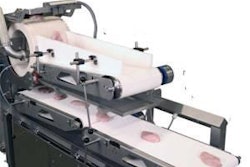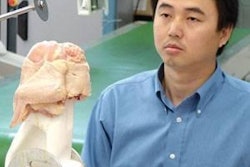Suppression of salmonella infection is emerging as a significant cost factor in the production of table eggs. A series of European Union (EU) directives aimed at reducing salmonellosis in consumers is one reason for the evaluation of procedures through the entire chain of production. Egg producers should use available knowledge concerning the epidemiology of infection and control measures to influence decisions on housing, management systems and feeding of flocks extending from quality control of ingredients through post-harvest handling, storage and delivery of eggs. They should also assess the cost and potential effectiveness of salmonella prevention measures according to the risks and consequences of infection in their areas of operation.
Most of the world's poultry industries and all commercial primary breeders have eradicated Salmonella pullorum and S. gallinarum, which are historically the major vertically transmitted salmonella pathogens of poultry, responsible for extensive losses. Paratyphoid serotypes are generally innocuous to chickens with the exception of S. enteritidis (SE), especially phage type 4.
Prevention of salmonella infection imposes direct costs attributed to enhanced biosecurity, vaccination, feed additives and surveillance. In the event of outbreaks involving serotypes associated with human infection, statutory measures including flock depletion, diversion of eggs to pasteurisation or other restrictions may be mandated either with or without compensation. Costs associated with salmonella infection are generally quantifiable if they involve direct expenditures.
Epidemiology and prevention measures
The three major Group-D salmonella serotypes of significance to poultry (S. pullorum, S. gallinarum, S. enteritidis) are vertically transmitted through eggs. Unless appropriate eradication and surveillance measures are imposed, these infections will be perpetuated. Vertical transmission is a significant problem with S. enteritidis, since infected hens at the commercial level can potentially transmit SE to consumers unless appropriate precautions including refrigeration, handling and food preparation are followed.
All salmonella can be transmitted by direct contact between infected permanent carriers and susceptible flocks. Modern principles of biosecurity generally dictate single-age flocks operated on an all-in-all-out programme with decontamination of housing between cycles. Indirect transmission, which can occur through fomites, can be suppressed by appropriate biosecurity measures.
Feed represents an important source of infection, especially if animal byproducts are incorporated in diets. Pasteurization by pelleting, addition of organic acids to lower pH value and feeding all-vegetable diets screened for the presence of salmonella will reduce the probability of food-borne transmission. These measures impose costs through formulating more expensive diets, sacrificing performance or expenditure on additives.
Rodents represent an important reservoir of salmonella infection and programmes to eliminate infestation require structural modifications to buildings and the purchase and placement of baits. Decontamination of vehicles, equipment and housing requires water, energy, detergents and disinfectants in addition to labour and supervision.
Vaccination has become an important component of control where Salmonella enteritidis has emerged as a public health concern. Feed additives, including mannanoligosaccharides, will reduce intestinal colonisation and shedding as salmonella with type-1 fimbria are agglutinated by the mannose component within the lumen and are excreted without adherence to enterocytes. Both defined and non-defined competitive exclusion cultures are administered to flocks by producers to reduce intestinal colonisation and hence contamination of eggs.
Financial impact of salmonella infection
Costs associated with prevention, detection and control of salmonella infection vary considerably according to region of operation, size and scope of an enterprise and production practices which are dictated by regulations. Salmonella prevention checklist illustrates cost components which relate to egg production with an emphasis on SE. Similar approaches with appropriate modifications can be applied to breeding, parent-level multiplication, commercial production and the production and processing of turkeys and broilers.
The extent of measures required to suppress salmonella infection in eggs is a function of the risks and consequences of a foodborne incident in addition to compliance with regulatory considerations. Evidence of SE or other salmonella serotypes may result in diversion of eggs to breaking plants to produce pasteurised liquid or eggs can be subjected to in-shell pasteurisation. Both these alternatives are expensive. In the USA, eggs consigned for breaking bring less than 70 percent of their wholesale value as nest-run product. In-shell pasteurisation may cost between 12 and 18 cents a dozen and involve the loss of up to 10 percent of eggs as a result of thermal cracking.
Quantifying costs of salmonella control
It is possible for individual producers to make projections about costs and benefits of specific salmonella prevention measures according to the risks and consequences of infection in their areas of operation. Vaccination with a live-attenuated product is a simple and inexpensive preventive measure. Enhanced biosecurity could involve structural measures (fences, hardened roadways, rodent proofing) and procedural components (protective clothing for workers and visitors, decontamination of vehicles). Total expenditure over a 50-week cycle, in this example, would be $15,200, imposing an incremental cost of 1.3 cents per dozen.
In the example, it is presumed that the flock of 50,000 hens is infected with SE after transfer due to defective biosecurity. Environmental infection is detected on routine surveillance at 45 weeks of age. This finding, on confirmation would require diversion of eggs for the remaining 25 weeks of the cycle to a breaking plant. The magnitude of the loss is based on the current US differential between nest-run revenue and the 33 percent discount imposed by breaking plants to cover yield loss and processing. Other costs would include intensified decontamination of housing and installations with monitoring at the end of the cycle. Subsequent flocks would require an immunisation programme, including inactivated emulsion vaccine administered by intramuscular injection to prevent possible vertical transmission of SE.
Table 3 tabulates the cost of an SE outbreak in the hypothetical flock given probabilities of infection in a given cycle ranging from absolute certainty (1.0) to no infection (0). Costs vary from $218,700 with a probability of 1 to a loss of $15,200 with no infection, since the costs of prevention would still be incurred. It is noted that irrespective of infection, the enterprise would incur an annual cost of $15,200 for prevention independent of SE infection.
This relatively simple evaluation has not assigned an efficiency factor to protective measures either individually or collectively. Generally, it can be concluded that an acceptable benefit to cost ratio of approximately 4 would be obtained at a 0.3 probability of infection before 45 weeks of age. The breakeven value for the expenditure of $15,200 per 50-week cycle would be in the region of 0.1, equivalent to one outbreak in 10 annual cycles. It must also be remembered that the consequences of a food-borne salmonella incident would involve indirect losses which have not been considered in this simple calculation. These may be extremely high as a result of regulatory sanctions, loss of goodwill, deferred sales and possible legal action.
In the USA, Latin America and other regions, table eggs are washed using chlorine-based detergent sanitisers at 100 to 150 ppm concentration, with a pH of 10 to 12 and a temperature of approximately 65 C followed by rinsing with water at 70 C. This procedure removes potential surface contamination with salmonella. In the EU, washing of eggs is not allowed which is regarded as an unjustified deviation from optimal food safety.
Ensure that all eggs with defective shells are removed from the product stream by candling and electronic crack detection modules. Eggs with damaged shells have a high probability of becoming contaminated with salmonella.
Packed eggs should be cooled to 10 C as quickly as possible after packing and should be held at this temperature through the chain of distribution to the point of sale.



.jpg?auto=format%2Ccompress&fit=crop&h=167&q=70&w=250)












